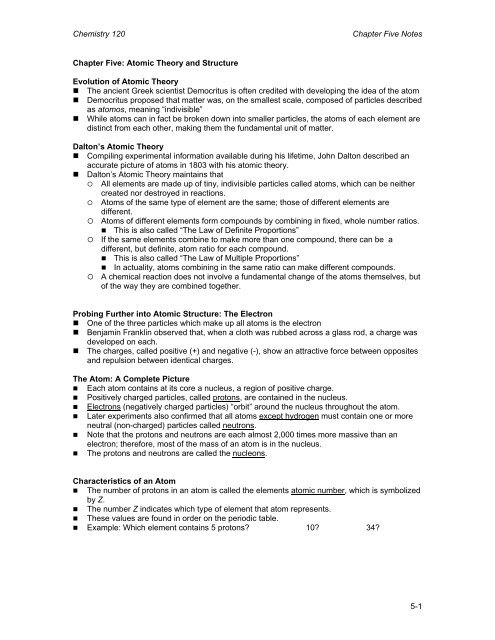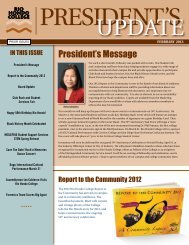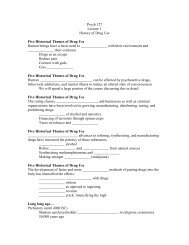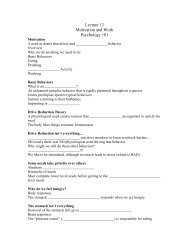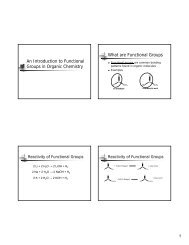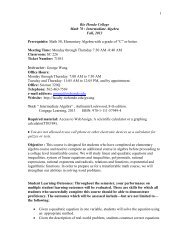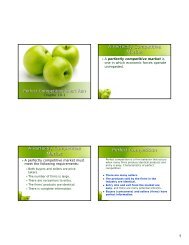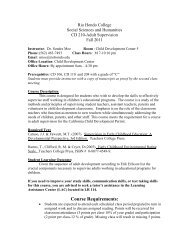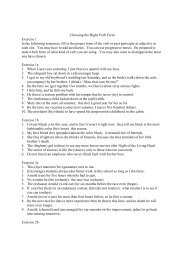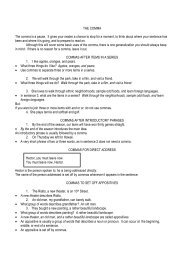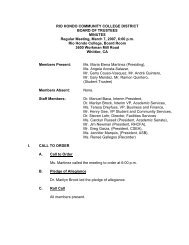You also want an ePaper? Increase the reach of your titles
YUMPU automatically turns print PDFs into web optimized ePapers that Google loves.
<strong>Chemistry</strong> <strong>120</strong><br />
Chapter Five <strong>Notes</strong><br />
Chapter Five: Atomic Theory and Structure<br />
Evolution of Atomic Theory<br />
• The ancient Greek scientist Democritus is often credited with developing the idea of the atom<br />
• Democritus proposed that matter was, on the smallest scale, composed of particles described<br />
as atomos, meaning “indivisible”<br />
• While atoms can in fact be broken down into smaller particles, the atoms of each element are<br />
distinct from each other, making them the fundamental unit of matter.<br />
Dalton’s Atomic Theory<br />
• Compiling experimental information available during his lifetime, John Dalton described an<br />
accurate picture of atoms in 1803 with his atomic theory.<br />
• Dalton’s Atomic Theory maintains that<br />
◦ All elements are made up of tiny, indivisible particles called atoms, which can be neither<br />
created nor destroyed in reactions.<br />
◦ Atoms of the same type of element are the same; those of different elements are<br />
different.<br />
◦ Atoms of different elements form compounds by combining in fixed, whole number ratios.<br />
• This is also called “The Law of Definite Proportions”<br />
◦ If the same elements combine to make more than one compound, there can be a<br />
different, but definite, atom ratio for each compound.<br />
• This is also called “The Law of Multiple Proportions”<br />
• In actuality, atoms combining in the same ratio can make different compounds.<br />
◦ A chemical reaction does not involve a fundamental change of the atoms themselves, but<br />
of the way they are combined together.<br />
Probing Further into Atomic Structure: The Electron<br />
• One of the three particles which make up all atoms is the electron<br />
• Benjamin Franklin observed that, when a cloth was rubbed across a glass rod, a charge was<br />
developed on each.<br />
• The charges, called positive (+) and negative (-), show an attractive force between opposites<br />
and repulsion between identical charges.<br />
The Atom: A Complete Picture<br />
• Each atom contains at its core a nucleus, a region of positive charge.<br />
• Positively charged particles, called protons, are contained in the nucleus.<br />
• Electrons (negatively charged particles) “orbit” around the nucleus throughout the atom.<br />
• Later experiments also confirmed that all atoms except hydrogen must contain one or more<br />
neutral (non-charged) particles called neutrons.<br />
• Note that the protons and neutrons are each almost 2,000 times more massive than an<br />
electron; therefore, most of the mass of an atom is in the nucleus.<br />
• The protons and neutrons are called the nucleons.<br />
Characteristics of an Atom<br />
• The number of protons in an atom is called the elements atomic number, which is symbolized<br />
by Z.<br />
• The number Z indicates which type of element that atom represents.<br />
• These values are found in order on the periodic table.<br />
• Example: Which element contains 5 protons 10 34<br />
5-1


